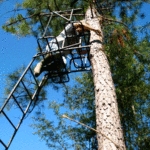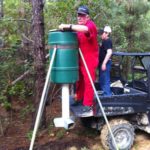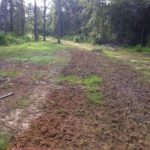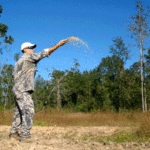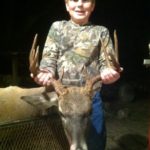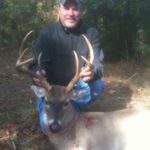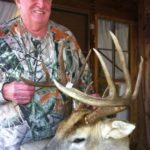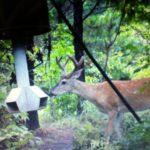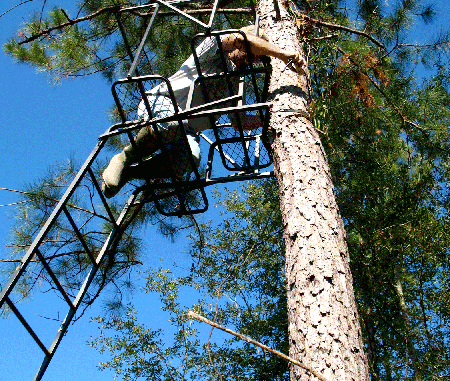
Pine plantations might not be the best habitat, but piney woods definitely hold deer. It’s just a matter of refining your block of woods to find the winner within.
My son tossed a block of wood onto the counter and asked me to help him turn it into a car that would win his local Cub Scouts’ annual Pinewood Derby race.
I stared at it a while and wondered how in the heck we were going to turn a stretched-out looking cube of wood into a car that would roll down a track in style.
But with the help of my dad’s wood shop, we marked out a design and clamped that featureless block of wood into a vise.
We cut away all parts of the wood that didn’t look like a car.
We sanded on it a little while, and the car began to take shape.
We painted. We weighted. We glued on some accessories.
Before we knew it, that plain old block of wood became the New Orleans Saints Superbowl Speedster that won the race.
Was it making chicken salad out of chicken crap? No, not really. But we did take an ordinary block of wood and turn it into something a lot better than what it was.
The car was in there; we just had to help it come out.
The same could be said for deer hunting on a pine plantation.
The deer are in there. You just have to help them come out.
To put the bottom line at the beginning, whether commercial leases or private land, pine-tree plantations dominate the Louisiana landscape because they offer the fastest rate of return.
Therefore, more Louisiana hunters have been subjected to sitting on stands attached to pine trees than ever before.
Some of them see deer. Many of them do not.
Two Louisiana hunters who have seen plenty deer in piney woods are Brandon Carter and Dennis Tietje.
Carter, the host of Reel Shot TV on the Sportsman Channel, grew up hunting the piney woods of the Florida Parishes.
Tietje, a Bassmaster Elite Series pro and Toledo Bend crappie guide, has hunted pine plantations in North and South Louisiana for as far back as he can remember.
Both know that, like that plain block of wood my son threw on the counter, there is more to a pine plantation than meets the eye. The key for both hunters is to cut, carve, mold and adjust until the end result is diverse deer habitat in the middle of a biological desert.
Here are some pine plantation management and hunting practices that have worked to turn Tietje and Carter’s featureless pine plantations into winning blocks of woods.
Plan ahead
If you own your own property, Tietje said one of the best things you can do is plan ahead by leaving shooting lanes unplanted at planting time.
“When you’re starting with a clear cut that you’re going to plant, find a spot where you want to locate a stand and leave unplanted 10-yard-wide strips going out in three directions from your stand site,” Tietje suggested.
Anybody who has ever looked at satellite imagery or aerial maps of pine plantations and timber company land will immediately recognize these kinds of locations as “turkey foot” plots because of their three prongs leading out from a central hub.
“You can catch deer through the day moving within a plantation, and they’re subject to feed during the day because where deer feel more protected in the daylight hours is in a thick pine plantation,” Tietje pointed out.
Cultivate thinning lanes
If you didn’t plan ahead or you hunt a lease owned by a timber company, one of the best things you can do in a pine plantation to develop a food source for deer is to keep the lanes created by thinning operations clean and cultivated.
“Not only does this thinning open up the canopy and let sunlight in,” Tietje said, “but all that machinery actually cultivates the lanes for you a little bit. That allows all these fresh sprouts to grow for a couple years.”
For Carter, keeping these lanes clean means keeping woody vegetation to a minimum by discing these thinning lanes.
“By discing, you’re releasing new seeds from the seed bank, resulting in numerous new forbs, grasses and weeds that the deer desire,” he explained. “This provides a variety of new growth that is more nutritious and palatable to the deer.”
Controled burning
If pine plantations are left unattended for several years, Carter said one of the best management techniques to cleanse the understory of woody growth that is not beneficial to deer is to conduct controlled burns.
“As the woody vegetation reaches heights taller than a deer, the leaves are no longer within reach of the animals, and they begin to shade out the lower-growing forbs that are better for deer,” Carter explained. “The burn also removes straw and leaf material that carpets the forest floor and prevents new forbs and grasses from emerging.”
Besides allowing new growth, controlled burns also release the used nutrients within the scorched plants back into the soil to start the cycle all over again.
“I would always recommend getting the assistance of a professional to conduct burns,” Carter cautioned. “Care must be taken to build a fire break around the entire perimeter of the burn area, and the wind must be taken into account.”
One major key to a controlled burn is a nice, gentle wind in a favorable direction. You want the fire to travel slow enough to get a thorough burn that removes all debris rather than one moving so fast that it jumps across the fire break.
“Moisture is also a concern,” Carter said. “It has to be dry enough to burn, but not so dry that the fire gets too hot and damages the pine stand or gets out of control. Burning smaller sections at a time is best in most cases.
“And burns that are best for deer take place in late winter or early spring before spring green-up, if possible.”
Plant a food plot
“Don’t ever think that just because it’s a pine plantation that you can’t go out there and plant a viable food plot,” Tietje said. “Deer don’t eat pine needles — well they might, but if you ever find needles in their stomachs, you’re in real trouble because they have nothing else to eat.
“So planting a food source where they really need one can pay off.”
Tietje has found that winter wheat works best for him because it continues to grow during the cold months after natural browse is burned off by frost.
“Believe it or not, if I can’t get a tractor in, I find a spot where some sunlight is hitting the ground, and throw wheat seed out by hand fairly thick and let it fall down through the needles. It will actually grow,” he said. “But you need to do that right ahead of a rain. It won’t be a perfect plot, but some is better than none.”
If he has room to get a tractor into an area, Tietje prepares a better food plot by discing, spreading lime, fertilizing and planting clovers.
Fertilize natural browse
If there isn’t enough sunlight to germinate clovers, wheat or brassicas, Carter fertilizes natural vegetation with a focus on preferred browse like green briars, honeysuckle, muscadine and anything else he routinely sees the tops being nipped by deer.
“Even something like hedge privets, which are usually not desirable in timber stands, can provide attractive browse,” Carter pointed out. “Deer love to nip off the new growth, so keep them trimmed to waist height and fertilize them.
“The deer will devour the new sprigs.”
Carter also keeps an eye out for old, mature oak trees within a pine plantation. He has had success digging holes with post-hole diggers all around the drip line of oak trees and filling them with fertilizer.
“You get bigger and more numerous mast production,” Carter said. “Fertilizing any kind of natural vegetation can help concentrate the deer a little better.”
Hunt contrast zones
Pine plantations are generally vast expanses of timber with very little variance. If you can narrow down your focus by finding some type of contrast like a small ditch, natural opening, a differing age class of timber or even a single oak tree, that can increase your odds of seeing deer.
For Tietje, this means hunting creek bottoms.
“With the timber programs in Louisiana, they really restrict the harvesting along the bottoms,” he said. “They have to leave 20 yards on either side of a creek to prevent erosion. Well, that’s where all the hardwoods are found, so if you have a bottom going through your pines, there’s your food source.”
And regardless of what kind of contrast zone you decide to hunt, Carter feels it is extremely important to remain vigilant on the stand.
“Since there are not many features that dictate how the deer travel, they can appear anywhere and at any time,” he noted.
Sidestep bedding areas
Tietje said he learned a long time ago not to walk down any ridges within a pine plantation because that’s where deer are going to bed.
Instead, he avoids the interior of a plantation all together.
“What I’m doing is walking through the feeding ground versus the bedding ground,” Tietje explained. “Ideally, I’d like to walk through a creek bottom to get to my stand. That way, I’m not walking through the middle of the pines and blowing all those deer out.”
Walking in to a stand where deer are going to be as opposed to where they are can definitely put the odds in your favor. And if your deer are anything like Tietje’s, don’t be surprised if they walk the same trail through the feeding area you walked in on just hours earlier.
Hunt the outer edges
Since deer use pine plantations as bedding grounds, Tietje said his favorite scenario for hunting pine trees is to set up at a corner where he can watch two edges of the pines at the same time.
“Pines are thick enough for deer to feel secure, so they stay in them during the day,” he explained. “But late in the evening, they come out to feed, and they use the edges of those pines as kind of a staging area until they feel it’s safe enough to come on out.”
Sometimes they may come out of the edges of the pines 30 minutes before dark, and sometimes they come out well after dark.
“My theory is that I stand to intercept these deer before they leave the pines versus me trying to go into the heart of the plantation where I will jump them up and run them out,” Tietje said.
Bring in bait
Baiting deer is perfectly legal in Louisiana, and Pineville resident Porter Trimble, who works with Honey Brake Lodge near Saline-Larto Lake in Central Louisiana, takes advantage of that by offering his own deer-delivery service.
“I’ve not had much success planting in pine thickets where sunlight can’t hit the ground,” he pointed out. “I’ve had much more success with feeders. I’ll feed acorn- or apple-flavored pellets in the early season.”
But Trimble has had even more success with rice bran. He places small piles of rice bran in multiple locations, but he makes sure to pour out as many as 10 piles and as few as three piles right at the bases of trees rather than out in the bald open.
“I make sure I’ve got a clean shot to each of those piles,” Trimble continued. “I don’t know why, but they seem to eat it better at the base of a tree. A buddy of mine told me this, and I didn’t believe him. Well, I tried it, and he was correct.”
What Trimble has found even stranger is that deer seem to like it better poured at the bases of pine trees than at the bases of oak trees.
Use available scent
One great thing about hunting pine plantations is the availability of free natural scent. Tietje and Carter both use pine needles to blend in with their surroundings, although each does it in different ways.
“I like to grab a handful of pine needles from a short tree on my way in and crush them up in my hand,” Tietje explained. “Then I rub them all over my boots and clothes, hats — everything.”
Carter doesn’t mind rubbing a few needles on his clothes as he enters the woods, but he makes sure his clothes already smell like pine trees before he even leaves the house.
“I pack my clothes bag with green pine needles to try to eliminate deer spooking downwind,” Carter said. “That way my clothes smell like the woods I’m going to be hunting.”
There is no doubt that hunting Louisiana’s vast pine plantations present many more challenges than hunting other kinds of deer woods.
But, like that pinewood derby car just waiting to be discovered in a block of wood, there are lots of deer just waiting to be discovered in pine woods.
Eliminate the areas that don’t look like they would hold deer. Polish up the natural areas that attract deer. And add some accessories until you’ve created your own winner.
Before you know it, you’ll have transformed an ordinary block of woods into the winner of your own pinewood deer derby.
